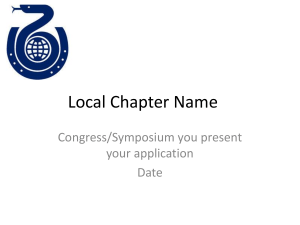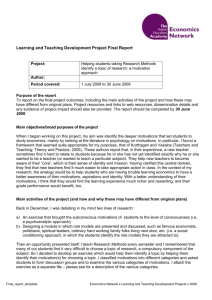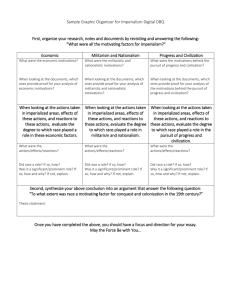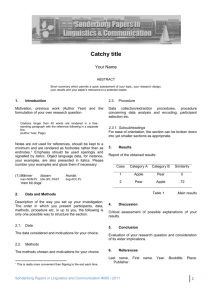Motivations and Expectations for Asking Questions Within Online Q&A
advertisement
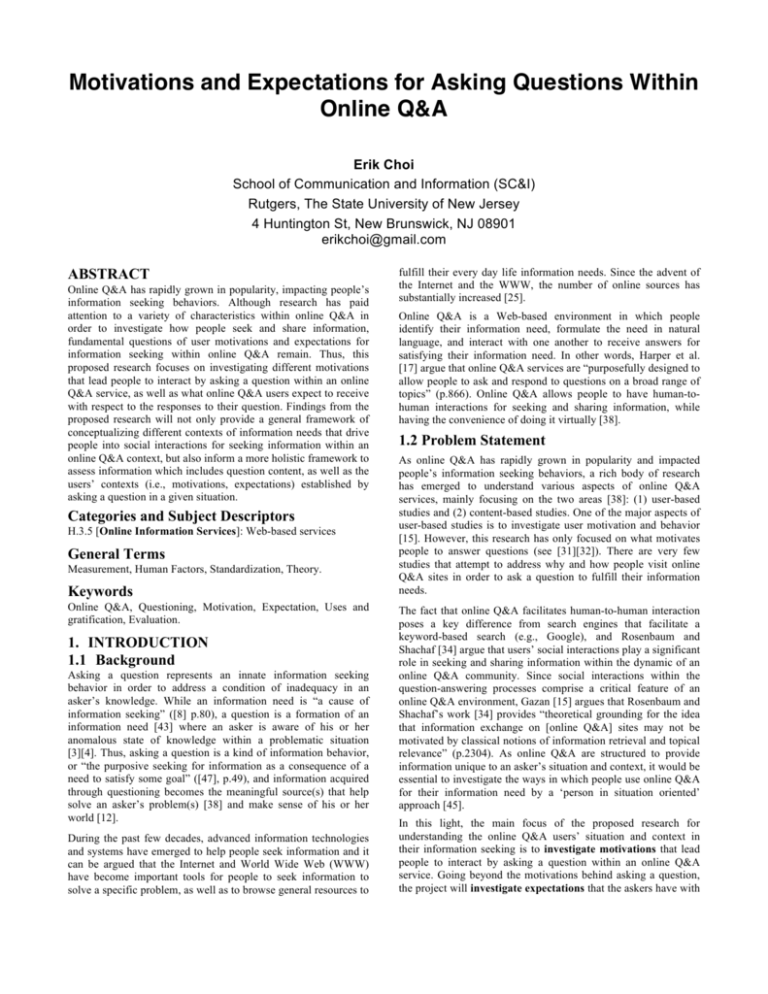
Motivations and Expectations for Asking Questions Within Online Q&A Erik Choi School of Communication and Information (SC&I) Rutgers, The State University of New Jersey 4 Huntington St, New Brunswick, NJ 08901 erikchoi@gmail.com ABSTRACT Online Q&A has rapidly grown in popularity, impacting people’s information seeking behaviors. Although research has paid attention to a variety of characteristics within online Q&A in order to investigate how people seek and share information, fundamental questions of user motivations and expectations for information seeking within online Q&A remain. Thus, this proposed research focuses on investigating different motivations that lead people to interact by asking a question within an online Q&A service, as well as what online Q&A users expect to receive with respect to the responses to their question. Findings from the proposed research will not only provide a general framework of conceptualizing different contexts of information needs that drive people into social interactions for seeking information within an online Q&A context, but also inform a more holistic framework to assess information which includes question content, as well as the users’ contexts (i.e., motivations, expectations) established by asking a question in a given situation. Categories and Subject Descriptors H.3.5 [Online Information Services]: Web-based services General Terms Measurement, Human Factors, Standardization, Theory. Keywords Online Q&A, Questioning, Motivation, Expectation, Uses and gratification, Evaluation. 1. INTRODUCTION 1.1 Background Asking a question represents an innate information seeking behavior in order to address a condition of inadequacy in an asker’s knowledge. While an information need is “a cause of information seeking” ([8] p.80), a question is a formation of an information need [43] where an asker is aware of his or her anomalous state of knowledge within a problematic situation [3][4]. Thus, asking a question is a kind of information behavior, or “the purposive seeking for information as a consequence of a need to satisfy some goal” ([47], p.49), and information acquired through questioning becomes the meaningful source(s) that help solve an asker’s problem(s) [38] and make sense of his or her world [12]. During the past few decades, advanced information technologies and systems have emerged to help people seek information and it can be argued that the Internet and World Wide Web (WWW) have become important tools for people to seek information to solve a specific problem, as well as to browse general resources to fulfill their every day life information needs. Since the advent of the Internet and the WWW, the number of online sources has substantially increased [25]. Online Q&A is a Web-based environment in which people identify their information need, formulate the need in natural language, and interact with one another to receive answers for satisfying their information need. In other words, Harper et al. [17] argue that online Q&A services are “purposefully designed to allow people to ask and respond to questions on a broad range of topics” (p.866). Online Q&A allows people to have human-tohuman interactions for seeking and sharing information, while having the convenience of doing it virtually [38]. 1.2 Problem Statement As online Q&A has rapidly grown in popularity and impacted people’s information seeking behaviors, a rich body of research has emerged to understand various aspects of online Q&A services, mainly focusing on the two areas [38]: (1) user-based studies and (2) content-based studies. One of the major aspects of user-based studies is to investigate user motivation and behavior [15]. However, this research has only focused on what motivates people to answer questions (see [31][32]). There are very few studies that attempt to address why and how people visit online Q&A sites in order to ask a question to fulfill their information needs. The fact that online Q&A facilitates human-to-human interaction poses a key difference from search engines that facilitate a keyword-based search (e.g., Google), and Rosenbaum and Shachaf [34] argue that users’ social interactions play a significant role in seeking and sharing information within the dynamic of an online Q&A community. Since social interactions within the question-answering processes comprise a critical feature of an online Q&A environment, Gazan [15] argues that Rosenbaum and Shachaf’s work [34] provides “theoretical grounding for the idea that information exchange on [online Q&A] sites may not be motivated by classical notions of information retrieval and topical relevance” (p.2304). As online Q&A are structured to provide information unique to an asker’s situation and context, it would be essential to investigate the ways in which people use online Q&A for their information need by a ‘person in situation oriented’ approach [45]. In this light, the main focus of the proposed research for understanding the online Q&A users’ situation and context in their information seeking is to investigate motivations that lead people to interact by asking a question within an online Q&A service. Going beyond the motivations behind asking a question, the project will investigate expectations that the askers have with respect to the responses they get for their questions. As Hsu et al. [19] argue, “an individual’s motivation to perform a certain activity is a function of the expectation that he or she will be able to perform the activity and obtain the desired outcomes, and the personal value of all outcomes associated with that activity” (pp. 284-285). Therefore, it can be argued that motivation and expectation are interrelated in achieving a specific goal or desirable outcome. Thus, it is also important to investigate what online Q&A users expect to receive with respect to the responses to their question, as well as how users’ motivations and expectations are related to each other when asking a question within online Q&A. people have more trust (24.8%) in the answers provided by their social network. Users also tend to believe (15.2%) that social networking sites perform better than search engines in addressing subjective questions seeking opinions or recommendations (21.5%). 1.3 Research Questions 2.3 Expectation RQ1. What motivates people to interact with others to ask a question that addresses their information need within online Q&A services? People anticipate, or expect that when they articulate an information need, they will receive information sources that fulfill this need. In order to assess how well an information source fulfills their information need, people employ evaluative criteria. Therefore, it can be argued that the evaluation of an information source in relation to these criteria articulates a user’s expectations for this source. RQ2. What are an asker’s expectations from others to fulfill his or her information need when asking a question within online Q&A services? RQ3. How do the motivations of asking a question relate to the expectations of information content within each type of online Q&A service? 2. BACKGROUND 2.1 Online Q&A services Online Q&A services have provided outlets for information retrieval where the users’ information need is formed by natural language questions posed to a community whose members can answer the question or even offer feedback on the given responses, resulting in a personalized set of answers generated via the collective wisdom of many [5]. Since the early 2000s, online Q&A services have become popular on the Web and, according to a Hitwise report, there was an 889% increase in visits to online Q&A services between 2006 and 2008 within the U.S [42]. Due to the popularity of use of online Q&A services as an information-seeking method and availability of data from them, different types of online Q&A services have emerged and are currently available for helping people to fulfill their information needs in various ways. There are four different types of online Q&A services: community-based (e.g., Yahoo! Answers), collaborative (e.g., WikiAnswers), expert-based (e.g., digital reference service), and social Q&A (e.g., Facebook). This typology was generated based on the author’s review and identification of the unique characteristics of different Q&A services, as well as informed by previous research studies focusing on online Q&A services [9]. 2.2 Motivation Previous studies have focused on motivations within online Q&A sites. Lee et al. [24] studied information seeking behaviors for searching for music-related information within two different types of online services (Yahoo! Answers, Google Answers), and identified the most significant information need as identifying either the artist and/or work. In a recent study by Zhang [49], she analyzed health related question from Yahoo! Answers, and identified the three motivational factors: cognitive motivation, social motivation, and emotional motivation. Additionally, Morris et al. [29] examined social networking sites (e.g. Facebook, Twitter) in order to investigate the types of questions asked and users’ motivations for using their social networks to pose questions. The study found that the most common reason is that However, previous studies of motivations within the online Q&A environments have been constricted by either specific interests and/or domains. It remains necessary to investigate a variety of online Q&A services consisting of a broad range of topics in order to gain insights into the user motivations for asking a question within online Q&A sites as a whole, over other information sources. Previous literature examines the evaluative criteria employed to judge the results of an information search, and most of these criteria can also be used to determine the expectations of online Q&A users for information received to answer their question. These evaluative criteria appear to be grounded by an overarching construct, most often quality, satisfaction, and/or relevance. For example, Taylor [44] likened the evaluation of information to making a quality-based assessment, and found five values that comprise quality: accuracy, comprehensiveness, currency, reliability, and validity. On the other hand, Barry [2] identified the act of evaluation to not be determined by making a quality-based assessment, but rather a satisfaction-based one. He identified criteria such as background/experience, consensus within the field, external verification, source quality, source reputation/visibility, effectiveness, time constraints, etc., as hallmarks of satisfaction. Studies of criteria employed to evaluate information have also been conducted within the context of online Q&A services. For example, Janes, Hill, and Rolfe [21] analyzed digital reference services, focusing on the characteristics of questions as well as responses received to the given questions. Findings indicated that additional/alternative information in relation to the requestor’s stated information need proved an important factor in determining the quality of responses within expert-based reference services. In addition, Kim, Oh, and Oh [23] investigated evaluation criteria employed by online Q&A users to select a Best Answer within Yahoo! Answers. The study indicated that utility (effectiveness, solution feasibility) proves the most critical factor in evaluating answers, followed by socio-emotional value. A recent study by Shah and Kitzie [37] found that trustworthiness constitutes one of critical factors in making evaluative judgments within the online Q&A environments. Previous research focused on either motivations for asking a question to seek information or the evaluations made of information, which articulates a user’s expectations for the service within online Q&A. However, these studies have not considered the relationship between motivations and expectations for the users’ information seeking behavior within online Q&A. The proposed research will start with the assumption that both motivation and expectation for asking a question within an online Q&A environment constitute the intervening processes for all following aspects of information seeking behavior that occur. 3. METHODOLOGY (PROPOSAL) The proposed research will use a mixed-methods design [11], more specifically a sequential mixed method design [30] that involves quantitative research followed by qualitative research for the single study. It is argued that quantitative and qualitative approach could complement each other, as well as develop more comprehensive data analysis for the study [40] and sharpen the understanding of findings in the study ([14], [41]). 3.1 Phase 1 - An internet-based survey The first phase of the study will focus on the quantitative data collection for identifying and generalizing characteristics of online Q&A users’ motivations and expectations for asking questions and their relationships. To do so, an Internet-based survey will be conducted to constitute a useful data collection for analyzing significant phenomena based on a frequency by which each type of motivation and expectation within an online Q&A user’s behavioral processes is identified. The target population in this study will be online Q&A users, who actively ask questions in order to fulfill their needs within online Q&A sites. In the study, online Q&A sites will include Yahoo! Answers, WikiAnswers, the Public Internet Library (virtual reference service), Facebook, and Twitter in which people formulate their needs in natural language and interact with other site members to seek answers. A total of 200 participants who use online Q&A sites will be targeted to recruit for the survey in quantitative research. Following is an outline of various analyses with the data from the preliminary survey in this proposed research. First, to investigate motivations behind asking questions over other online information sources, the proposed research will conduct descriptive statistical analyses to measure participants’ responses on the survey questionnaire that identify different types of information need from previous studies of motivations of media use [22][28], as well as their expectations. These analyses will address the research questions (RQ1 and RQ2). Moreover, other statistical analyses will be used to measure correlations between the motivations for asking a question and their corresponding expectations to their question, and to investigate how changes in motivations as the independent variable relate to changes in, expectation within online Q&A (RQ3). 3.2 Phase 2 – Log data This proposed research will use log data in order to collect information about what questions people ask and when they do in online Q&A sites prior to conduct in-depth interviews for qualitative research. Since in-depth interviews attempt to investigate and examine specific situations or incidents where the users ask a question within online Q&A, conducting log data collection with in-depth interview participants before the interview will provide records of their questioning behaviors. Log data allows the researcher to collect comprehensive records of users’ every events and activities online [6], and to collect objective and quantitative information about online users’ behavior patterns [33]. In the study, this data collection method could be useful to quantify what type of questions people tend to ask within online Q&A, as well as have the participants keep a diary of their motivations and expectations for asking questions during the data collection period. Information collected via log data will be used for in-depth interviews in phase 3. Coagmento (http://coagmento.org) will be used in order to collect each in-depth interview participant’s log data. Coagmento is a plug-in for Firefox browser, which can be served as a client level log data collection for this study. This tool will not only automatically collect their anonymized Web search information, but also allow interview participants’ to manually keep a diary for their questioning behaviors for each time when they ask questions within online Q&A sites. For the second and third phase for qualitative research in this study, maximal variation sampling will be used in order to seek representative samples for multiple cases in qualitative research. Maximal variation sampling is a purposeful sampling that the researcher selects different sample cases, which “represent the complexity of our world” ([10], p.194). This sampling “yields detailed descriptions of each case, in addition to identifying shared patterns that cut across cases” ([18], p.54), which maximizes the diversity, close to the whole populations, in the study. Identifying how many cases this study should be selected for qualitative research is dependent upon the data collection and analysis in the quantitative research, but approximately 15-20 participants for qualitative research will be targeted to select based on participants’ responses to: (1) gender, (2) age, (3) general web search behaviors, (4) history of online Q&A site use, (5) motivations and expectations for asking questions, and (6) their relationships when asking questions within online Q&A sites, in order to explore their unique and common phenomena [35] of questioning behaviors. 3.3 Phase 3 – In-depth interviews In this study, multiple case studies [36] based on online Q&A users’ experiences of questioning with emphasis on their motivations behind asking questions, as well as expectations from other users with respect to their answers to the question will be used for conducting qualitative research. A case study can be served as “a holistic inquiry that investigates a contemporary phenomenon within its natural setting” ([16], p.1) in order to explore specific real-time situations or incidents where people ask questions and address “why" questions [11] about asking questions within online Q&A sites. In-depth phone interviews will be conducted with approximately 15-20 participants representing each case identified through quantitative research. Data collection for in-depth interviews is based on the principles of Critical Incident Technique (CIT) as a qualitative approach [7][20] in order to study more specific situations or incidents of the users’ questioning behaviors for seeking information, as well as their expectations from others based on their questions on the online Q&A sites. Since the CIT also examines more complex sets of behavioral intentions [46] and a flexible set of procedures designed to collect data of participants’ behaviors during actual situations [27], the CIT in the study will collect direct observations of online Q&A users’ questioning behaviors. This will provide insights into specific situations or incidents of the users’ questioning behaviors, and pave ways to find answers to the research questions posited in the proposed research. The interview may take approximately 45-60 minutes to investigate the participants’ motivations and expectations for asking questions. The phone interview will be audio-taped with permission of the interview participants and each participant will be asked to recall and describe situations where they ask a question to seek information within online Q&A over other online information sources. To analyze the collected data, the data will be transcribed into a word processor and organized with each unique critical incident being developed in users’ questioning within online Q&A. 4. PRELIMINARY RESEARCH 4.1 Method A survey was used in order to measure users’ motivations and expectations of asking a question in Yahoo! Answers, one of the test beds in the proposed research. In order to recruit respondents, a link to an online version of the survey was sent to users who enabled email links to be displayed on their profiles. The first email for survey participation was distributed from March 10th to March 17th, 2013. An additional reminder email was sent out to those solicited in the week following the first survey distribution. The previous typologies of media use [22][28] were adapted in order to investigate what motivates people ask a question within online Q&A. In addition, evaluation criteria frequently mentioned within the previous literature was selected in order to explore how expectations are associated with these different motivations and how expectations relate to type of question asked. Like the motivations portion of the survey, each expectation factor was measured on a 5-point Likert scale. 4.2 Results 4.2.1 Motivations When examining survey responses to the Likert scale items within the motivations portion of the survey (Table 1), the subcategories, learning; self-education through acquiring information (Mean=3.56) from high-level category, cognitive needs, and having fun asking a question in Yahoo! Answers, (Mean=3.56) from tension-free needs, are identified as the most influential motivational factors in asking a question in Yahoo! Answers. Table 1. Descriptive statistics of motivations. Motivation Cognitive needs Finding relevant information in immediate surroundings, society and the world Seeking advice or opinions for making decisions Learning; self-education through acquiring information Gaining a sense of security through knowledge Affective needs Looking for social and emotional support for personal issues Looking for social and emotional support for someone (e.g., family, friends, etc.) Looking for attainment on personals or ideas Personal integrative needs Finding support for one’s own values Gaining insight into one’s own life Experiencing empathy with problems of others Mean 3.39 3.33 S.D. 0.89 1.18 3.40 3.56 1.36 1.21 3.25 2.54 2.51 1.32 1.19 1.42 2.20 1.31 2.91 2.74 2.68 2.76 2.79 1.30 1.20 1.40 1.35 1.35 Social integrative needs Identifying with others and gaining a sense of belonging Finding a basis for conversation and social interaction Having a substitute for real-life companionship Feeling connected with other people 2.42 2.52 1.13 1.29 2.96 1.35 1.96 2.57 1.22 1.29 Tension free needs Having fun asking a question on Yahoo! Answers Filling time Emotional release 3.00 3.56 2.88 2.57 1.15 1.34 1.46 1.43 Additionally, seeking advice or opinions for making decisions (Mean=3.40), finding relevant information (Mean=3.33), and gaining a sense of security through knowledge (Mean=3.25), all from the cognitive needs high-level category, constitute the other significant motivational factors for users to ask a question in Yahoo! Answers. It is interesting to note that having a substitute for real-life companionship from the social integrative needs category, constitutes the least identified motivational factor (Mean=1.96), and since the other social factors are more than one standard deviation from this mean, this suggests that an online environment provides a socio-affective dimension that is separate from the one encountered in real life. 4.2.2 Expectations When examining survey responses to the Likert scale items within the motivations portion of the survey (Table 2), the categories looking for additional or alternative information (Mean=4.03), looking for accurate or complete information (Mean=4.01), looking for a quick response (Mean=3.92), and looking for trustworthy sources (Mean=3.70) constituted the most influential expectation factors for asking a question in Yahoo! Answers. The least significant expectation is looking for social and emotional support (Mean=2.47). It is interesting to note that the categories most similar to the cognitive needs identified in the motivations portion of the survey also seem to be more highly rated in the expectations portion, and that socio-emotional support factors seem to be among the lowest. This suggests that correlations between these items will also be high. It is also interesting to note that for the expectations portion, the standard deviations tend to be a little lower (except for the social and emotional support category, which might further make an argument to the point made above that people distinguish this support from within an online Q&A site as compared to what they experience face-to-face), which suggests that users were more in agreement on the expectation criteria presented than the motivation criteria. Table 2. Expectations of information sources in Yahoo! Answers. Expectation Mean S.D. Quick responses 3.92 1.10 Additional or alternative information 4.03 1.01 Accurate and complete information 4.01 1.12 Social and emotional support 2.47 1.40 Verification of one’s own beliefs or knowledge 3.32 1.19 Trustworthy sources 3.70 1.14 4.2.3 Relationship expectations between motivations and When asking a question in Yahoo! Answers, cognitive motivations are significantly correlated (p<.01) with all expectations except looking for social and emotional support. However, there are correlations between the sub-levels seeking advice or opinions (r=.364) and gaining a sense of security through knowledge (r=.361) to social and emotional support, which suggests that there are socio-affective expectations inherent to cognitively motivated tasks; it just depends on the type of task. It is also noteworthy that respondents expect resources to be trustworthy across all levels of cognitive-based motivations, however expectations for information that is accurate and complete only experience a significant correlation with finding relevant information in immediate surroundings, society, and the world (r=.415). Motivations concerning affective needs significantly, and predictably, correlate to expectations for social and emotional support (r=.515), as well as verification of one’s own knowledge (r=.370). However, it is somewhat surprising that they also correlate to expectations for quick responses (r=.229). It is interesting to note that the expectation for a quick response experiences significant positive correlations with each sub-level except looking for attainment of information based on personal thoughts or ideas within the affective motivations category. Additional motivations such as personal integrative needs, social integrative needs, and tension-free needs are only statistically correlated with two expectation factors (looking for social and emotional support, looking for verification of one’s own beliefs or knowledge). However, if motivated to ask a question in Yahoo! Answers to pass time, users are more likely to expect to receive additional or alternative information to their given question (r=.276). 5. EXPECTED IMPLICATIONS Understanding users’ motivations behind asking a question as well as their expectations with respect to the responses within online Q&A is a critical endeavor that could provide a general framework of conceptualizing different contexts of information needs that drive people into social interactions for seeking information within an online Q&A context. Focusing on an online Q&A user’s behavioral processes by incorporating an asker’s motivations and expectations will enable us to understand the contexts in use of online Q&A services to socially interact, as well as seek and share information within an online Q&A environment. Moreover, one of the main aspects in the studies of online Q&A is to measure information relevance and quality. To do so, previous studies attempting to analyze information quality in online Q&A have paid attention to textual (e.g., length of the answer’s content) and non-textual features (e.g., Information from the answerer’s profile) (see [39] for details of criteria employed for predicting information quality) to evaluate the quality of information. Even though the recent research has also focused on new criteria (e.g., politeness, novelty, timeless, etc.) that can be employed to assess the quality of information [23][26][38][39] in order to analyze how information satisfies an asker’s need, there is still a lack of consideration of an asker’s problems or the situational context behind asking a question within an online Q&A service. As Agichtein, Liu, and Bian [1] suggest, the importance of personalized approaches for each individual information seeker to evaluating the quality of information can yield recommendations on the assessment of information quality in online Q&A. Therefore, findings from the proposed research can help not only in identifying why and how users are engaged in information seeking within an online Q&A context to satisfy their information needs, but also in developing more comprehensive personalized approaches of information relevance and satisfaction, including the motivations and expectations of users when seeking information. 6. ACKNOWLEDGMENTS I would like to express my gratitude to my advisor, Dr. Chirag Shah, as well as my proposal committee member, Dr. Nicholas J. Belkin, for their guidance and support for this research proposal. I would also like to thank my colleague, Vanessa Kitzie for her time and effort for reviewing the proposal. 7. REFERENCES [1] Agichtein, E., Liu, Y., & Bian, J. (2009). Modeling information-seeker satisfaction in community question answering. ACM Transactions on Knowledge Discovery from Data (TKDD) 3(2). [2] Barry, C. L. (1994). User-defined relevance criteria: An exploratory study. Journal of the American Society for Information Science, 45, 149–159. [3] Belkin, N. J. (1980). Anomalous states of knowledge as a basis for information retrieval. Canadian Journal of Information Science, 5, 133-143. [4] Belkin, N. J., Oddy, R. N., & Brooks, H. M. (1982). ASK for information retrieval: Part I. Background and theory. Journal of Documentation. 38(2), 61-71. [5] Bian, J., Liu,Y., Agichtein, E., & Zha, H. (2008). Finding the Right Facts in the Crowd: Factoid Question Answering over Social Media. In Proceedings of WWW Conference, 467– 476. [6] Bruckman, A. (2006). Analysis of log file data to understand behavior and learning in an online community. In J. Weiss, J. Nolan, J. Hunsinger, & P . Trifonas (Eds.), The International handbook of virtual learning environments (pp. 1449–1465). Netherlands, Springer. [7] Bycio, P., & Allen, J. S. (2004). A critical incidents approach to outcomes assessment. Journal of Education for Business, 80(2), 86–92. [8] Case, D.O. (2002). Looking for information: A survey of research on information seeking, needs, and behavior. Amsterdam: Academic Press. [9] Choi, E., Kitzie, V., & Shah, C. (2012). Developing a Typology of Online Q&A Models and Recommending the Right Model for Each Question Type. In Proceedings of ASIST Conference. Baltimore, Maryland. [10] Creswell, J. W. (2002). Educational research: Planning, conducting, and evaluating quantitative and qualitative research. Upper Saddle River, NJ: Merrill. [11] Creswell, J. W. (2003). Research design: Qualitative, quantitative, and mixed methods approached (2nd ed.). Thousands Oaks, CA: Sage Publications. [12] Dervin, B. (1992). From the mind’s eye of the user: The sense-making qualitative-quantitative methodology. In Glazier, J. and Powell, R. R. Qualitative research in information management (p. 61-84). Englewood, CA: Libraries Unlimited [13] Feather, N. T. (1982). 'Expectancy-value approaches: Present status and future directions.' In N. T. Feather (Ed.), Expectations and actions: Expectancy-value models in psychology (pp. 395-420). Hillsdale, NJ: Erlbaum. [14] Gay, L. R., & Airasian, P. (2000). Educational research: Competencies for analysis and application (6th ed.). Upper saddle River, NJ: Merrill. [15] Gazan, R. (2011). SQA. Journal of the American Society for Information Science & Technology 62(12), 2301-2312. [16] Harling, K. (2002). An Overview of Case Study. Paper presented at the American Agricultural Economics Association annual meeting, Long Beach, California. Retrieved from http://www.farmfoundation.org/projects/documents/1_harlin g.pdf [17] Harper, F.M., Raban, D., Rafaeli, S., & Konstan, J.A. (2008). Predictors of Answer Quality in Online Q&A Sites. In Proceedings of CHI 2008, 865-874. [18] Hoepfl, M. C. (1997). Choosing qualitative research: A primer for technology education researchers, Journal of Technology Education, 9(1), 47-63. [19] Hsu, C. H. C., Cai, L. A., & Li, M. (2010). Expectation, motivation, and attitude: A tourist behavioral model. Journal of Travel Research, 49, 282-296. [20] Jacoby, J., & O’Brien, N. P. (2005). Assessing the impact of reference services provided to undergraduate students. College & Research Libraries, 66(4), 324–340. [21] Janes, J., Hill, C., & Rolfe, A. (2001). Ask-an-expert services analysis. Journal of the American Society for Information Science, 52(13), 1106-1121. [22] Katz, E., Gurevitch, M., & Haas, H. (1973). On the use of the mass media for important things. American Sociological Review, 38, 164–181. [23] Kim, S., Oh, S., & Oh, J.-S. (2009). Evaluating Health Answers in a Social Q&A Site. In Proceedings of ASIST Conference, 45(1), 1-6. [24] Lee, J. H., Downie, J. S., & Cunningham, S. J. (2005). Challenges in cross-cultural/multilingual music information seeking. In Proceedings of the 6th International Society for Music Information Retrieval (pp.1−7). London, UK. [25] Levy, A. Y., Rajaraman, A., & Ordille, J. J. (1996). Querying heterogeneous information sources using source descriptions. In Proceedings of 22th International Conference on Very Large Data Bases, 251–262. [26] Liu, Y., Bian, J., & Agichtein, E. (2008). Predicting information seeker satisfaction in community question answering. In S-H. Myaeng, D. W. Oard, F. Sebastiani, T-S Chua, & M-K. Leong (Eds.), Proceedings of the 31st Annual International ACM SIGIR Conference on Research and Development in Information Retrieval (pp. 483−490). New York: ACM. [27] Miller, J. L., Craighead, C. W., & Karwan, K. R. (2000). Service recovery: a framework and empirical investigation. Journal of Operations Managemen, 18, 387–400. [28] McQuail, D. (1983). Mass Communication Theory (1st ed.). London: Sage. [29] Morris, M. R., Teevan, J., & Panovich, K. (2010). What do people ask their social networks, and why?: a survey study of status message q&a behavior. In Proceedings of the ACM CHI Conference (pp. 1739-1748). Atlanta, Georgia, USA: ACM. [30] Morse, J. M., & Niehaus, L. (2009). Mixed method design: Principles and procedures. Walnut Creek, CA: Left Coast Press. [31] Nam, K. K., Ackerman, M. S., & Adamic, L. A. (2009). Questions in, Knowledge iN?: A study of Naver’s question answering community. In Proceedings of ACM CHI Conference, 779-788. [32] Oh, S. (2012). The characteristics and motivations of health answerers for sharing information, knowledge, and experiences in online environments. Journal of American Society of Information Science & Technology, 63(3), 543557. [33] Rieger, O. Y. (2009). Search engine use behavior of students and faculty: User perceptions and implications for future research. First Monday, 14(2). Retrieved from http://firstmonday.org/article/view/2716/2385 [34] Rosenbaum, H., & Shachaf, P. (2010). A structuration approach to online communities of practice: the case of Q&A communities. Journal of the American Society for Information Science and Technology, 61(10), 1933–1944. [35] Sandelowski, M. (1995). Sample size in qualitative research. Research in Nursing & Health, 18, 179-183. [36] Stake, R. E. (1995). The art of case study research. Thousand Oaks, CA: Sage. [37] Shah, C., & Kitzie, V. (2012). Social Q&A and Virtual Reference – Comparing Apples and Oranges With the Help of Experts and Users. Journal of American Society of Information Science & Technology, 63(10), 2020-2036. [38] Shah, C., Oh, S., & Oh, J. S. (2009). Research agenda for SQA. Library & Information Science Research, 31(4), 205209. [39] Shah, C., & Pomerantz, J. (2010). Evaluating and predicting answer quality in community QA. In Proceedings of ACM SIGIR Conference, 411-418. [40] Tashakkori, A., & Teddlie, C. (1998). Mixed methodology: Combining qualitative and quantitative approaches. Applied Social Research Methods Series, 46. Thousand Oaks, CA: Sage Publications. [41] Tashakkori, A., & Teddlie, C. (2003). The past and future of mixed methods research: From data triangulation to mixed model designs. In A. Tashakkori, & C. Teddlie (Eds.), Handbook of mixed methods in social and behavioral research (pp. 671-702). Thousand Oaks, CA: Sage. [42] Tatham, M. (2008). U.S. Visits to Question and Answer Websites Increased 118 Percent Year-over-Year Yahoo! Answers receives 74 percent of all U.S. visits. Hitwise. Retrieved from http://www.hitwise.com/presscenter/hitwiseHS2004/question-and-answer-websites.php [43] Taylor, R. S. (1968). Question-negotiation and information seeking in libraries. College and Research Libraries, 29, 178-194. [44] Taylor, R. S. (1986). Value-added processes in information systems. Norwood, NJ: Ablex Publishing. [45] Vakkari, P. (1997). Information seeking in context: A challenging metatheory. In P. Vakkari, R. Savolainen, & B. Dervin (Eds.), In Proceedings of an International Conference on Research in Information Needs, Seeking and Use in Different Contexts (pp. 451–464). London: Taylor Graham. [46] Urquhart, C., Light, A., Thomas, R., Barker, A., Yeoman, A., Cooper, J., et al. (2003). Critical incident technique and explicitation interviewing in studies of information behavior. Library and Information Science Research, 25(1), 63-88. [47] Wilson, T. D. (2000). Human information behavior. Informing Science, 3(2), 49-55. [48] Yang, S. (1997). Information seeking as problem-solving using a qualitative approach to uncoverthe novice learners' information-seeking process in a perseus hypertext system. Library and Information Science Research, 19(1), 71-92. [49] Zhang, Y. (2010). Contextualizing consumer health information searching: An analysis of questions in a Social Q&A community. In Proceedings of the 1st ACM International Health Informatics Symposium, 210-219.
